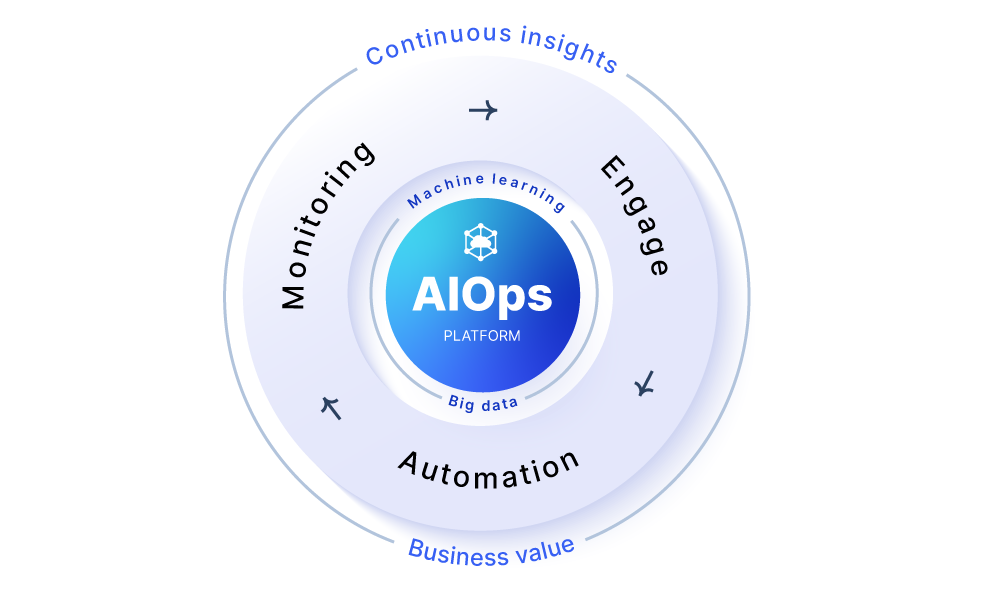Essential Guide to Building an Effective AIOps Strategy

We often hear about the many benefits AIOps (Artificial Intelligence for IT Operations) brings to businesses.
But how can you develop an effective AIOps strategy? Where do you even start? What are the best practices or implementation challenges? These and many more questions must be answered before beginning your AIOps journey.
In this guide, we will explore the steps for creating an effective AIOps strategy and discuss crucial components, obstacles, and best practices for successful implementation.
The Need for AIOps
Traditional monitoring and alerting methods, often called a “black box approach”, offer limited insight into system performance. This would mean that IT teams rely on reactive approaches, where they only respond to incidents after they occur without any type of planning or strategy.
By integrating AI, machine learning, and big data analytics, AIOps platforms can enhance IT operations, reduce downtime, and improve service delivery.
With AIOps, your team can take a proactive approach to managing IT operations. Let’s examine the main benefits of AIOps and the challenges it helps resolve.
Benefits of Implementing AIOps
- Improved efficiency: Automating manual processes frees IT teams to focus on higher-value tasks, reducing mean time to repair (MTTR).
- Proactive incident management: Teams can predict and prevent system failures, minimizing downtime and service disruptions.
- Enhanced decision-making: Real-time insights into system performance and root cause analysis improve decision-making, leading to faster issue resolution.
- Reduced alert fatigue: Intelligent alerting software filters out unnecessary alerts and prioritizes critical issues, relieving IT teams and helping them reduce the noise.
- Less manual interventions: Automating routine tasks like incident management and event handling reduces the need for manual intervention, improving overall operational efficiency.
Discover more AIOps benefits in our comprehensive guide about the top 10 AIOps use cases.
Key Components of an AIOps Strategy

A well-structured AIOps strategy requires integrating various components, which can help you achieve more streamlined and automated IT operations. Let’s examine them in more detail.
Data Collection and Integration
For AIOps to function effectively, continuous data collection from multiple sources is essential. This includes logs, metrics, and performance data from IT systems. Integrating this data into a central platform allows for accurate analysis and actionable insights.
Another essential component is the data lake, which is designed to facilitate the storage, management, and analysis of vast amounts of data in their raw, native format. It supports structured, semi-structured, and unstructured data, providing organizations with flexibility and scalability.
Phased Implementation Roadmap
A Phased Implementation Roadmap for AIOps is a strategic approach designed to integrate AIOps technologies into an organization’s IT operations. This roadmap breaks down the complex process into manageable phases, facilitating gradual adoption, testing, and scaling.
By following these structured steps—assessing current infrastructure, defining clear objectives, piloting solutions, and scaling effectively—organizations can leverage AIOps to enhance IT operations while minimizing disruption during transition periods.
Monitoring and Event Management
AIOps enhances traditional monitoring by enabling real-time event correlation and anomaly detection. This allows IT teams to spot irregularities and address issues sooner.
Machine Learning and Analytics
AIOps employs machine learning algorithms to analyze patterns and make predictive insights. By processing historical and real-time data, machine learning data helps you detect root causes and predict future issues.
Automation and Orchestration
Effective incident management requires establishing clear protocols for automated responses to common issues. AIOps leverages automation to improve workflows and optimize processes. This includes automated incident triage, root cause analysis, and workflow automation—all of which enable end-to-end incident management, reduce manual effort, and ensure faster response times.
By clearly defining conditions for automated actions, teams can ensure that routine incidents are managed promptly and accurately, freeing up resources to focus on more complex challenges.
5 Best Practices for Implementing an AIOps Strategy
Implementing AIOps requires a thoughtful approach grounded in best practices to ensure maximum benefit.
Everbridge xMatters helps organizations achieve seamless AIOps implementation with its robust incident management software, automation, and real-time alerting. Here’s how to get started:
-
Start with a Clear Vision and Goal
From the start, it can be tricky to accurately assess what you need from AIOps and estimate how much time and effort it will require to integrate it into your systems.
It is worthwhile to take the time to scope out your goals and current capabilities. Start by identifying your team’s pain points—such as alert fatigue or slow incident responses—and determining where AIOps can most impact them.
-
Ensure High-Quality Data
Even the most advanced AIOps platform will struggle to deliver value without quality or proper data. Invest in systems that ensure the accuracy and completeness of the data your AIOps solution relies on.
xMatters integrates with your existing tools and ensures that data is collected and processed in real-time, allowing for more accurate event correlation and predictive analytics.
-
Foster Interdepartmental Collaboration
IT teams, data scientists, business leaders, or other relevant collaborators must work together to align AIOps goals with broader organizational objectives.
With xMatters, cross-functional collaboration becomes more accessible through its automated alerting and communication features, ensuring that the right teams are engaged when incidents occur.
-
Invest in Training and Skill Development
Equip your teams with the necessary skills to manage and leverage AIOps effectively. Ongoing training programs can help bridge knowledge gaps and keep teams updated on the latest AI and machine learning trends.
xMatters supports organizations with easy-to-use tools that reduce incident management complexity with automation, helping teams focus on core tasks without extensive technical knowledge.
-
Monitor and Optimize Continuously
AIOps isn’t a “set it and forget it” solution. Continuous monitoring and optimization are essential to ensure your AIOps platform delivers maximum value over time.
xMatters provides analytics, monitoring, and insights, helping teams continuously improve their incident response and overall system performance.
Challenges and Solutions of AIOps Strategies
Now that we know the benefits and best practices to start our AIOps strategy, we must recognize some of its most common challenges. By understanding these, you can better prepare and devise practical solutions to mitigate them.
-
Data Quality and Management
High-quality data is the foundation of AIOps. Without clean, accurate, and comprehensive data, AIOps solutions can deliver flawed insights or inaccurate predictions. Ensuring your data is reliable is key to AIOps’ success.
-
Integration with Existing Systems
Integrating AIOps with legacy systems or existing tools can be challenging. To avoid disruptions, your organization must ensure its AIOps platform is compatible with the current infrastructure. Evaluate current tools for compatibility with AIOps solutions and ensure they can handle large volumes of data while providing advanced analytics capabilities.
-
Skill and Expertise Gaps
Implementing AIOps requires expertise in IT operations and AI. As your organization integrates advanced AIOps, you may face skill gaps, requiring investment in training and hiring. Of course, selecting a knowledgeable provider like xMatters can fill in that gap.
-
Change Management
Adopting AIOps may require significant shifts in organizational processes. Change management initiatives should focus on educating teams about the benefits of AIOps and ensuring that all departments are aligned with the new strategy.
-
Scalability
As IT environments grow, your organization must ensure its AIOps platform can scale accordingly to manage increasing data loads and complexity.
-
Security and Compliance
Implementing AIOps involves handling vast amounts of sensitive data, which can raise security and compliance concerns. Ensuring that AIOps solutions comply with industry standards is crucial for maintaining trust and avoiding potential legal issues. At xMatters, our priority is data security.
-
Costs
Deploying an AIOps platform can be costly, especially if your organization is just beginning its automation journey. However, the long-term gains in efficiency and operational savings often justify the upfront investment.
Look for solutions that offer comprehensive pricing plans, like xMatters, that scale as you grow without extra add-on costs.
Building an AIOps Strategy Is Easier With xMatters
As we have learned, implementing an AIOps strategy offers immense potential for IT operations. But it requires careful planning and execution. From ensuring data quality to overcoming integration challenges, organizations need a solid approach to leverage AIOps.
As a leading service reliability platform, Everbridge xMatters supports organizations in their AIOps journey by providing robust data management, seamless automation capabilities, and comprehensive security and compliance features.
Download the AIOps Buyer’s Guide to learn about the use cases and key capabilities of the right AIOps tool.
Ready to transform your IT operations? Explore our solutions or request a demo to get started today.
